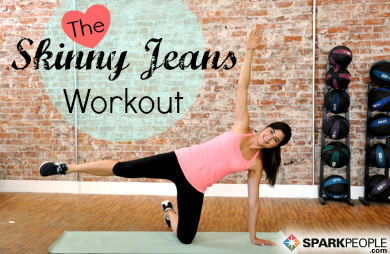|
You only have 45 minutes to spare for a workout. By the time you change your clothes, get outside or to the gym, and get moving, it’s really more like half an hour of sweat equity, though. Is it really worth the effort and energy if you can’t invest a full hour? The short answer: absolutely! It’s a myth that there’s some magic at the 60-minute mark when benefits start kicking in. In fact, many experts believe that the one-hour workout is dead. Even just 10 minutes of movement can go a long way toward burning calories, strengthening muscle and improving cardiovascular health. “Workouts are getting shorter, because people are getting very efficient with their time these days,” says Ashley Pitt, trainer and fitness blogger at A Lady Goes West. “One-hour workouts might stick around for classes and studios, but I think we will see the addition of 45-minute and 30-minute shorter sessions. You can get a lot done in that timeframe.” The key is maximizing your time, even if you only have a little to spare. Get the most out of your every workout minute—whether you have five minutes or 50—with these tips from professional trainers. 1. Prep your space.By laying the groundwork ahead of time, you’ll be able to hit the ground running and use every minute of your workout time for, well, working out. “If possible, set up your spot at home or in the gym with all of the equipment you'll need for your workout before you start,” suggests Sarah Ann Kelly from MomTrainer.com. “That way, you won’t have to waste time fumbling around and looking for the weights you'll need for your next set.” If your workout space happens to be the wide open road or a trail in the woods, you can still prep by setting out all the gear you’ll need for your run, walk or hike before the workout clock starts ticking. 2. Try Tabata.Pitt says the key to shorter workouts is going as hard as you can in intervals and using recoveries to regroup and restart. She likes making use of Tabata, a tough cardio sequence in which you work hard for 20 seconds, take 10 seconds off and then repeat for a total of four minutes. You can do any type of exercise during a Tabata—burpees, squat jumps, high-knee runs or whatever you prefer—as long as you work to your absolute max during each 20-second stint. Then, take the recovery and go hard again. If you do two rounds of Tabata, that's just eight minutes of work, but you’ll definitely feel the burn. Another short and simple interval workout Pitt recommends is alternating walking for one minute, then running for one minute until you get to 10 minutes. If you're on the treadmill, add some incline for an extra challenge to ramp up the calorie burn. Just remember that it's important to pump your arms and legs to power up the hill—refrain from holding onto the bars for support. 3. Try the P.A.U.L. MethodDani Singer, fitness trainer and director of Fit2Go Personal Training, specializes in helping busy working professionals exercise more efficiently. He created the P.A.U.L. method to help maximize the effectiveness of any 10-minute workout. It is named for the types of exercises it includes. Step One: Choose one exercise for each of the following four categories:
Step Three: Perform each exercise for 30 seconds, switching every time you hear the timer beep. Step Four: After performing all four exercises, rest 30 seconds and start again. Continue with this circuit four more times until you’ve reached 10 minutes. “The beauty of this 10-minute home workout is that you can count on doing it every single day,” says Singer. “And since you’re performing strength exercises back-to-back without rest, you’re strengthening your muscles while also burning fat. It kills two birds with one stone.” 4. Focus on the functional.When you’re short on time, fitness trainer Rui Li recommends targeting specific muscle groups that maximize your functional fitness, such as the glutes, hip flexors, lower abs, back and shoulder girdle. “There's no sense in targeting a muscle that ultimately doesn't help much with getting you functionally stronger, so if you have less time, be selective with your focus, and choose one or two muscle groups each time,” she suggests. As personal trainer Jen Mueller points out, functional fitness is training specifically designed to improve balance and power as related to your everyday routines. It incorporates movements designed to mimic real-life activity. For instance, if you often reach up to put things on a shelf or retrieve them, incorporating a dumbbell press into your workout will help strengthen your shoulders and prevent injury from those repetitive motions. 5. Rock the circuit.Circuit training is a type of workout that combines multiple exercises, each of which trains a different muscle group. You rotate from one circuit to the next, interval style, with a short period of rest between each exercise. Lui often uses circuit training to help her clients get the maximum benefit from their sessions. If you’re really tight on time, she suggests creating a circuit and cutting out or shortening the breaks if it's safe to do so. “One of the reasons why workouts can take so long is because people take extended breaks in between sets,” she explains. “Cut that out and just go straight through. You'll get the bonus of some peripheral cardio [this way], too.” 6. Crank up your music.Ever notice that when a motivating, up-tempo song comes on during a workout, you tend to ramp up the intensity without even realizing it? If you’re running or walking, your pace will likely go up a bit, or you might squeeze in a few extra reps when lifting weights. Kelly points out that studies have shown music is linked to improved exercise performance. “By finding a playlist that gets you pumped, you'll likely work harder and faster,” she says. “If you've only got a short amount of time, you can use your music to make it worthwhile.” By incorporating some of these time-saving tricks, you can cut some of the “fat” from your exercise sessions, streamline your sweat schedule and get the most out of your designated workout window. |
Popular EntriesMore From SparkPeople
|





.png)
















